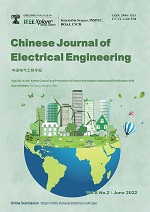|
|
An Economic Optimization Method for Demand-side Energy-storage Accident Backup Assisted Deep Peaking of Thermal Power Units*
Wen Wei, Ze Ye, Yali Wang, Shuangfeng Dai, Lei Chen, Xiaolong Liu
Chinese Journal of Electrical Engineering
2022, 8 (2):
62-74.
DOI: 10.23919/CJEE.2022.000015
With the large-scale penetration of new energy such as wind power, its anti-modulation peak characteristics have increased challenges in power systems. Therefore, an economic optimization method for depth peak regulation and the depth of the emergency of the Energy storage (ES) accident on the demand side is proposed. First, a quantitative model of unplanned disconnection risk caused by weather state, load level, and fault type is constructed to obtain the spare and available ES capacity. Therefore, a deep peak regulation (DPR) economic optimization model is established to minimize the fuel injection cost of thermal power units, including ES accident standby, unit damage, and fuel demand. The particle swarm optimization algorithm is used to simulate the modified IEEE 30-node system. Based on the results, the DPR of ES accident standby can reduce the wind abandonment rate by 1.1% and the total peak adjustment cost by 33.5% under class-A weather. In class-C weather, the wind abandonment ratio can be reduced by 4.19%, reducing the cost of the total adjustment peak by 31.4%. The multiple purposes of improving the power grid modulation, wind power, and the standby utilization of ES accidents can be achieved.
Reference |
Related Articles |
Metrics
|
|
